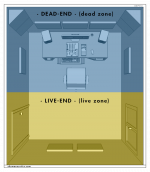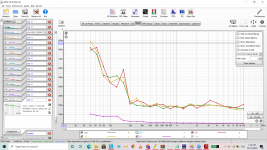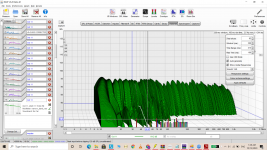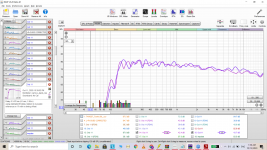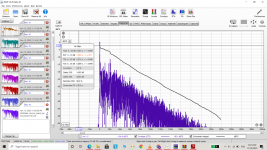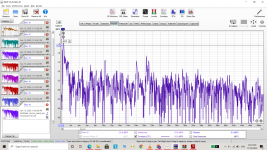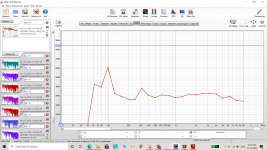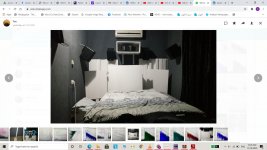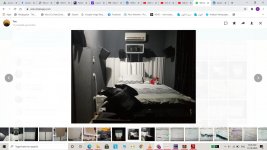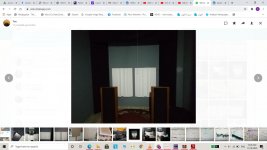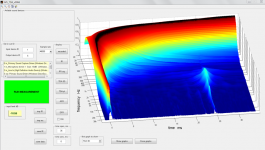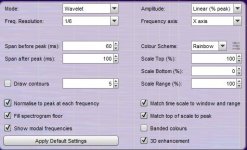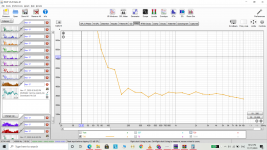Hello kind people!
i've been working on improving my room as much as possible for an accurate but enjoyable stereophonic experience.
My room is L shaped. two rooms basically, the total length is 5.6 meters, width of the first room is 3.3 meters, and the second room is 2.4 meters. height is 3.3 meters for both. made with concrete.
It's used for music primary and a home theater aswell.(the walls are covered in very thin black fabric to hide the rockwool panels and help with the projector's picture)
i'm using infinity kappa 8A speakers, tweeters are 70 cms away from the side walls for both speakers, and the back tweeters(they're dipoles) 60 cms away from the back wall.
sitting in an equilateral triangle with the speakers ,185 cms distance between the tweeters and each speaker and my head.
tweeters are toed firing and my ears(to interefere around 10 cms behind my head)
worked on the RFZ room approach, using 5 cm rockwool panels to absorb my first reflections, and to have a long ITDG. i treated my side walls, floor, ceiling and front wall(wall facing me), back wall is 3.3 meters away from me and according to my calculations it didn't need absorbtion(comfirmed by the ETC graphs)
i installed 10 cm thick rockwool panels on all the corners of the room, with 8 cms of air gap behind the rockwool.
i encountered big nulls in the 100-250 hz area, so i built 3 Front loaded horns 2 of them using 12 inch woofers flat to 16 hz and the 3rd using a 21 inch B&C woofer(designed as bed with output behind the head's listener for very near nearfield listening for movies) flat down to 12 hz in room.
and crossed the subs at 150 hz with the main speakers to get rid of most of the nulls.
using a minidsp 2x4HD i time alligned the speakers and subs, and PEQ'd them aiming for a Harman curve(the listener's curve mentioned in Dr floyd's sound reproduction book)
used FIR filters to correct the phase and improve my impulse response and ETC significantly.
i'll attach pictures of everything and would appreciate comments and helpful tips.
Fluid was pretty helpful on the Rephase thread, he and wasayso made some observations about the room's RT60 of 200ms being too dead(removing my panels didn't increase rt60), and that i can use reflections to improve the experience, like the possiblity of adding Haas kickers or ambience speakers.
I'm a bit confused about this topic, keeps reading different professional opinions this.
any helpful tips about anything i can do to improve the experience is much appreciated !
i've been working on improving my room as much as possible for an accurate but enjoyable stereophonic experience.
My room is L shaped. two rooms basically, the total length is 5.6 meters, width of the first room is 3.3 meters, and the second room is 2.4 meters. height is 3.3 meters for both. made with concrete.
It's used for music primary and a home theater aswell.(the walls are covered in very thin black fabric to hide the rockwool panels and help with the projector's picture)
i'm using infinity kappa 8A speakers, tweeters are 70 cms away from the side walls for both speakers, and the back tweeters(they're dipoles) 60 cms away from the back wall.
sitting in an equilateral triangle with the speakers ,185 cms distance between the tweeters and each speaker and my head.
tweeters are toed firing and my ears(to interefere around 10 cms behind my head)
worked on the RFZ room approach, using 5 cm rockwool panels to absorb my first reflections, and to have a long ITDG. i treated my side walls, floor, ceiling and front wall(wall facing me), back wall is 3.3 meters away from me and according to my calculations it didn't need absorbtion(comfirmed by the ETC graphs)
i installed 10 cm thick rockwool panels on all the corners of the room, with 8 cms of air gap behind the rockwool.
i encountered big nulls in the 100-250 hz area, so i built 3 Front loaded horns 2 of them using 12 inch woofers flat to 16 hz and the 3rd using a 21 inch B&C woofer(designed as bed with output behind the head's listener for very near nearfield listening for movies) flat down to 12 hz in room.
and crossed the subs at 150 hz with the main speakers to get rid of most of the nulls.
using a minidsp 2x4HD i time alligned the speakers and subs, and PEQ'd them aiming for a Harman curve(the listener's curve mentioned in Dr floyd's sound reproduction book)
used FIR filters to correct the phase and improve my impulse response and ETC significantly.
i'll attach pictures of everything and would appreciate comments and helpful tips.
Fluid was pretty helpful on the Rephase thread, he and wasayso made some observations about the room's RT60 of 200ms being too dead(removing my panels didn't increase rt60), and that i can use reflections to improve the experience, like the possiblity of adding Haas kickers or ambience speakers.
I'm a bit confused about this topic, keeps reading different professional opinions this.
any helpful tips about anything i can do to improve the experience is much appreciated !
Attachments
-
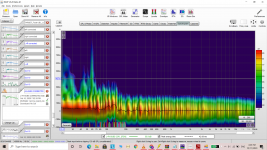 Screenshot (110).png939.3 KB · Views: 352
Screenshot (110).png939.3 KB · Views: 352 -
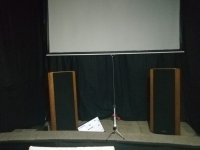 WhatsApp Image 2020-10-11 at 4.53.36 PM.jpeg59.2 KB · Views: 184
WhatsApp Image 2020-10-11 at 4.53.36 PM.jpeg59.2 KB · Views: 184 -
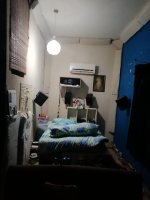 WhatsApp Image 2020-10-11 at 4.53.36 PM (1).jpeg74.4 KB · Views: 175
WhatsApp Image 2020-10-11 at 4.53.36 PM (1).jpeg74.4 KB · Views: 175 -
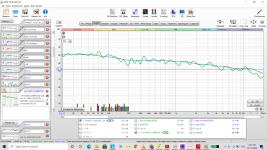 Screenshot (104).png594.3 KB · Views: 103
Screenshot (104).png594.3 KB · Views: 103 -
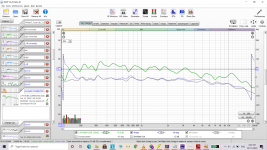 Screenshot (105).png584.5 KB · Views: 102
Screenshot (105).png584.5 KB · Views: 102 -
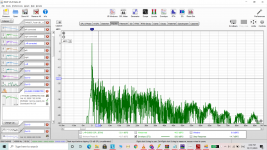 Screenshot (106).png578.5 KB · Views: 287
Screenshot (106).png578.5 KB · Views: 287 -
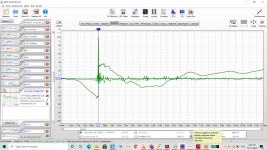 Screenshot (107).png549.5 KB · Views: 288
Screenshot (107).png549.5 KB · Views: 288 -
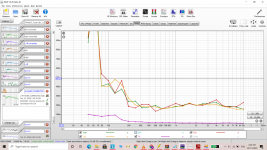 Screenshot (108).png550.6 KB · Views: 292
Screenshot (108).png550.6 KB · Views: 292 -
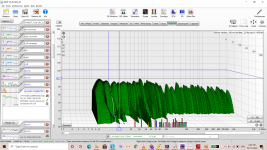 Screenshot (109).png837.7 KB · Views: 318
Screenshot (109).png837.7 KB · Views: 318
I'll copy the last post with questions you had on the other thread:
Instead of absorbing, or diffusing first reflections, you can also redirect that energy within your room (if you have that opportunity) to arrive from a different angle much later in time. That's what the thread I linked in my (previous) reply is all about: My Listening Room - Gearslutz Jim did an excellent job documenting the steps he took in that room.
What Jim did in that room is redirect the energy from what would have become a first reflection to steer it to the back of the room behind the listening position where a diffractive panel steers that (now late enough) energy back to the listening position. Just look into that thread, it's a really clever passive Haas kicker.
I won't argue about having a reflection free zone, that really does make a difference for a listening area. All we were saying is that later energy with the right properties can actually enhance what you observe subjectively from the stereo pair. In a dedicated room one can redirect or should I say re-use that energy for the benefit of the listening enjoyment.
You'd still have a reflection free zone, but the late energy can give you that bit extra, without loosing the precision imaging the RFZ is giving you. You get a more thrilling experience with envelopment if the key ingredients are right. Much like the things that sets a good venue apart from the bad ones out there. Very good info on the subject comes from David Griesinger of Lexicon fame. On his site you can find many good papers on the subject of envelopment and room properties and what they do for the listener.
If creating this ambience enhancement isn't doable using passive means, then there's the option to use ambient speakers that could double as surrounds for movies. That's what I ended up using in my living room as I did not have the opportunity to go wild there . Basic job of those ambient speakers is to hide the real properties/size of my actual room. Absorbing first reflections was part of that deal. Not entirely coincidental I do use a lexicon product to help me achieve what I'm after.
. Basic job of those ambient speakers is to hide the real properties/size of my actual room. Absorbing first reflections was part of that deal. Not entirely coincidental I do use a lexicon product to help me achieve what I'm after.
Disclaimer; I'm only describing what worked for me. I certainly don't know it all but have been on a years long quest to find what it is that I like. Much of that is documented in a really long thread that has already been running for years on end right here. Making it hard to navigate or find certain topics, sorry for that. The first post contains a few 'quick jumps' though. I'm not done yet, it has been way too much fun to stop now!
For quite a while I thought I should copy what Studios were doing as far as a listening environment goes. After some experiments I now feel we can do even better. The virtual ambience setup is versatile and open for experimenting. It definitely is one of my better or should I say more successful experiments.
this is awesome, i thank you for taking the time and writing this, learning many things here lately.
i'm a bit confused about a few things, everything i read about first reflections state that they should be treated, either by absorbtion or diffusion, absorbtion usually results in a better result and is far more economical.
basically anything below 20-25 ms, some argue up to 50ms.
are you saying i can use first reflections to end up with a more enjoyable experience? or use the late reflections after those 20 ms?
my room is dedicated for music listening but it's weird shaped. i'll post the details in the thread so i don't pollute this thread any longer.
i'll start a thread now and post a link in a few.
Instead of absorbing, or diffusing first reflections, you can also redirect that energy within your room (if you have that opportunity) to arrive from a different angle much later in time. That's what the thread I linked in my (previous) reply is all about: My Listening Room - Gearslutz Jim did an excellent job documenting the steps he took in that room.
What Jim did in that room is redirect the energy from what would have become a first reflection to steer it to the back of the room behind the listening position where a diffractive panel steers that (now late enough) energy back to the listening position. Just look into that thread, it's a really clever passive Haas kicker.
I won't argue about having a reflection free zone, that really does make a difference for a listening area. All we were saying is that later energy with the right properties can actually enhance what you observe subjectively from the stereo pair. In a dedicated room one can redirect or should I say re-use that energy for the benefit of the listening enjoyment.
You'd still have a reflection free zone, but the late energy can give you that bit extra, without loosing the precision imaging the RFZ is giving you. You get a more thrilling experience with envelopment if the key ingredients are right. Much like the things that sets a good venue apart from the bad ones out there. Very good info on the subject comes from David Griesinger of Lexicon fame. On his site you can find many good papers on the subject of envelopment and room properties and what they do for the listener.
If creating this ambience enhancement isn't doable using passive means, then there's the option to use ambient speakers that could double as surrounds for movies. That's what I ended up using in my living room as I did not have the opportunity to go wild there
Disclaimer; I'm only describing what worked for me. I certainly don't know it all but have been on a years long quest to find what it is that I like. Much of that is documented in a really long thread that has already been running for years on end right here. Making it hard to navigate or find certain topics, sorry for that. The first post contains a few 'quick jumps' though. I'm not done yet, it has been way too much fun to stop now!
For quite a while I thought I should copy what Studios were doing as far as a listening environment goes. After some experiments I now feel we can do even better. The virtual ambience setup is versatile and open for experimenting. It definitely is one of my better or should I say more successful experiments.
Last edited:
I totally get what you meant now, and it sounds awesome
Read a bit in your thread and saw the nail speakers you built, too excites to finish the thread so maybe you can make it a bit easier for me and tell. Me more about the ambient speakers? I'd prefer that option to the passive ones.
I already have a few bookshelves lying around that i can use, or is there anything specific about the ones i use?
Read about crossing them at 3500 or 7000 hz? What dis you end up Using?
I saw a picture on settinf it up behind the couch facing the left wall, what's the rule on placing them? What should they face?
How do i need to set them up? I can provide power and a 1st order crossover, my minidsp is used up and getting any DSP now is not an option i'm afraid
Thanls!!
Read a bit in your thread and saw the nail speakers you built, too excites to finish the thread so maybe you can make it a bit easier for me and tell. Me more about the ambient speakers? I'd prefer that option to the passive ones.
I already have a few bookshelves lying around that i can use, or is there anything specific about the ones i use?
Read about crossing them at 3500 or 7000 hz? What dis you end up Using?
I saw a picture on settinf it up behind the couch facing the left wall, what's the rule on placing them? What should they face?
How do i need to set them up? I can provide power and a 1st order crossover, my minidsp is used up and getting any DSP now is not an option i'm afraid
Thanls!!
Last edited by a moderator:
There are a couple of things that makes it work. The band-pass, making sure the material it plays is decorrelated, the time delay...
Even the cut-off frequency isn't simple to answer. I make my own mix for the ambience channels which consists of mid and side info. The side mix is cut off at 3.5 KHz, the mid at about 5.5 to 7 KHz. I fire them to the outsides to not get it's direct sound at the listening spot but the scattered reflections (decorrelating the sound from the mains). Further more I have a Random Hall reverb plugin from Lexicon involved.
The time delay is essential, to be able to time its arrival after the main wave front. I've played with all kinds of mixes, band-passes, reverbs and IR's and aiming those speakers, for instance up toward ceiling etc. The current mix has been the most successful, my own mid/side mix + a bit of reverb, band passed, time delayed and it's FR curve adjusted with DSP.
Pano once made a schematic of it, I think I adjusted some of the steps to be valid for my setup:

Even the cut-off frequency isn't simple to answer. I make my own mix for the ambience channels which consists of mid and side info. The side mix is cut off at 3.5 KHz, the mid at about 5.5 to 7 KHz. I fire them to the outsides to not get it's direct sound at the listening spot but the scattered reflections (decorrelating the sound from the mains). Further more I have a Random Hall reverb plugin from Lexicon involved.
The time delay is essential, to be able to time its arrival after the main wave front. I've played with all kinds of mixes, band-passes, reverbs and IR's and aiming those speakers, for instance up toward ceiling etc. The current mix has been the most successful, my own mid/side mix + a bit of reverb, band passed, time delayed and it's FR curve adjusted with DSP.
Pano once made a schematic of it, I think I adjusted some of the steps to be valid for my setup:

Last edited:
Maybe I should put forward another disclaimer or warning. The above schematic can be a bit daunting and I'm pretty sure my thread reads like the diary of a madman  .
.
It didn't all happen in one day though. It gradually evolved to this over a long period.
When talking about ambience channels it is key that you really don't notice that they are there. Until you turn them off. They kind of fake a better listening room/environment than what I can have in reality. By bringing in new (later timed) queues that resembles a much bigger space, replacing the energy I stole from my room through absorption. If you get it right it does sound awesome. Much more like being there with a holographic type of imaging. Entertaining, involving and enveloping. Early reflections obscure the image queues. These later timed ambience sounds, properly decorrelated, enhance it.
Even the late Mr. Linkwitz (may he rest in peace) has played with something similar. See: Surround stereo system but also his Watson experiments.
I have other trickery too, which can be seen in the above schematic. The mid-side wizardry that I started quite a while ago to battle cross talk, see the thread: Fixing the Stereo Phantom Center for more info on that phenomenon. As said, the work of a madman . Some may think I'm taking this way too far etc. But hey, it does work for me and a growing number of others that are willing (and have the means to) to experiment.
. Some may think I'm taking this way too far etc. But hey, it does work for me and a growing number of others that are willing (and have the means to) to experiment.
It didn't all happen in one day though. It gradually evolved to this over a long period.
When talking about ambience channels it is key that you really don't notice that they are there. Until you turn them off. They kind of fake a better listening room/environment than what I can have in reality. By bringing in new (later timed) queues that resembles a much bigger space, replacing the energy I stole from my room through absorption. If you get it right it does sound awesome. Much more like being there with a holographic type of imaging. Entertaining, involving and enveloping. Early reflections obscure the image queues. These later timed ambience sounds, properly decorrelated, enhance it.
Even the late Mr. Linkwitz (may he rest in peace) has played with something similar. See: Surround stereo system but also his Watson experiments.
I have other trickery too, which can be seen in the above schematic. The mid-side wizardry that I started quite a while ago to battle cross talk, see the thread: Fixing the Stereo Phantom Center for more info on that phenomenon. As said, the work of a madman
Last edited:
Jim's thread should be a good start to see how and what to do. Basically it is sort of a LEDE concept:
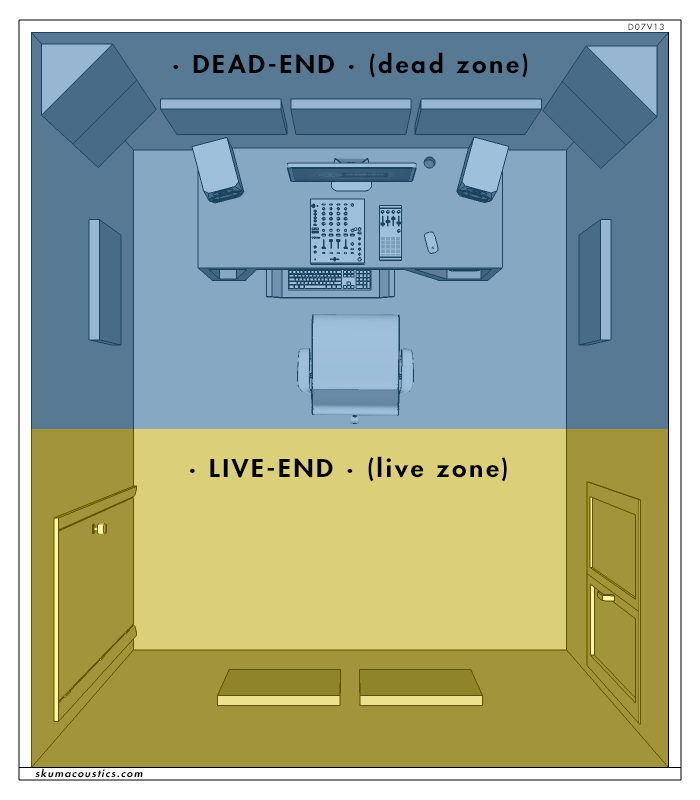
(picture borrowed from here: Senior Pack - Room kit - acoustic treatment | Skum Acoustics)
But it is adjustable, as we can push that 'live end' back wall behind the listener further away by either using reflection and diffraction panels like Jim did or by using time delay on a virtual solution like I did.
A bit more refined than that picture shows, as more work is done to control the content and arrival of that back room energy.
(picture borrowed from here: Senior Pack - Room kit - acoustic treatment | Skum Acoustics)
But it is adjustable, as we can push that 'live end' back wall behind the listener further away by either using reflection and diffraction panels like Jim did or by using time delay on a virtual solution like I did.
A bit more refined than that picture shows, as more work is done to control the content and arrival of that back room energy.
Attachments
Last edited:
i get that in your room the back wall was close to you, so "pushing" back the wall using the ambience speakers helped, in my case though i have around 3.3 meters behind me until i reach the back wall,do i still need to use a collection of reflection and diffraction panels to get the benefit?
i'm failing to find enough information on how to properly design a LEDE, if you can provide me with a research paper or any kind of tutorial.. to understand the design concept more, that would be great.
basically the first Dead end room is accomplished in my room, i need to learn how to use design,use and place reflectors or diffusers on the back of the room, and i'm set, correct?
And one more thing, looking at my rt60 and waterfall graphs, they differ below 200 hz, rt 60 says that at 50 hz per example, it takes 900 ms to decay, vs the waterfall's 300 ms at 50 hz, am i understanding this wrong?
i'm trying to figure out if i need more thickness in the bass traps to get more absorption below 200hz
i'm failing to find enough information on how to properly design a LEDE, if you can provide me with a research paper or any kind of tutorial.. to understand the design concept more, that would be great.
basically the first Dead end room is accomplished in my room, i need to learn how to use design,use and place reflectors or diffusers on the back of the room, and i'm set, correct?
And one more thing, looking at my rt60 and waterfall graphs, they differ below 200 hz, rt 60 says that at 50 hz per example, it takes 900 ms to decay, vs the waterfall's 300 ms at 50 hz, am i understanding this wrong?
i'm trying to figure out if i need more thickness in the bass traps to get more absorption below 200hz
Attachments
Last edited by a moderator:
In your room I'd start with a couple of home made diffuser panels placed strategically in the back of the room, a bit out to the sides if possible and see how you like that.
What Jim did was take the side wall energy, reflect that to the back of the room, bounce it once more and then use a diffractive panel. All of that to get the time delay he wanted.
Not easy and it took him quite a while to perfect it. But his measurements are top notch and clearly shows it works.
Even he experimented with extra ambience channels with reverb, can't say if he still uses that. We were both heavily inspired by the work of David Griesinger, eating his papers for breakfast .
.
You have a dead enough room, so placing the panels in the back and measuring it's arrival time and content should work to see where the (group of) reflection/diffraction is. I think Mr. Bill Waslo had some nice suggestions on DIY diffusive panels, it should be in this part of the forum, here it is: Making easy DIY "Depot" sound Diffuser panels, step by step.
That should get you started to have some fun!
I noticed an even better correction in the REW thread. Next make sure both left and right channels have as close to the same frequency curve as you can get.
For a well damped room I did find your frequency curve a bit wavy (small dips and peaks). Do you have floor and/or ceiling treatment as well?
What Jim did was take the side wall energy, reflect that to the back of the room, bounce it once more and then use a diffractive panel. All of that to get the time delay he wanted.
Not easy and it took him quite a while to perfect it. But his measurements are top notch and clearly shows it works.
Even he experimented with extra ambience channels with reverb, can't say if he still uses that. We were both heavily inspired by the work of David Griesinger, eating his papers for breakfast
You have a dead enough room, so placing the panels in the back and measuring it's arrival time and content should work to see where the (group of) reflection/diffraction is. I think Mr. Bill Waslo had some nice suggestions on DIY diffusive panels, it should be in this part of the forum, here it is: Making easy DIY "Depot" sound Diffuser panels, step by step.
That should get you started to have some fun!
I noticed an even better correction in the REW thread. Next make sure both left and right channels have as close to the same frequency curve as you can get.
For a well damped room I did find your frequency curve a bit wavy (small dips and peaks). Do you have floor and/or ceiling treatment as well?
these are my EQ'd left and right channels, it is wavy yes, and the left and right speakers are having a very different raw responses. i suspect the passive crossovers inside the infinities needs some recapping, they're causing phase issues even at nearfield testing.
i'm currently working on new speakers, spoiler:it involves a back loaded horn flat to 20 hz using a 6.5 inch driver
once they're done they're replacing my current speakers
and yes i'm using rockwool panels on the ceiling and a thick carpet on the floor.
Thank you for the link, i'll check it out!
i'm currently working on new speakers, spoiler:it involves a back loaded horn flat to 20 hz using a 6.5 inch driver
once they're done they're replacing my current speakers
and yes i'm using rockwool panels on the ceiling and a thick carpet on the floor.
Thank you for the link, i'll check it out!
Attachments
Last edited by a moderator:
That's exactly what I thought when I saw it here. Then realized that I drew it!The above schematic can be a bit daunting....
 Perhaps I need make a more basic diagram just to introduce the concept, then move on this is complex one.
Perhaps I need make a more basic diagram just to introduce the concept, then move on this is complex one.In your room I'd start with a couple of home made diffuser panels placed strategically in the back of the room, a bit out to the sides if possible and see how you like that.
What Jim did was take the side wall energy, reflect that to the back of the room, bounce it once more and then use a diffractive panel. All of that to get the time delay he wanted.
Not easy and it took him quite a while to perfect it. But his measurements are top notch and clearly shows it works.
Even he experimented with extra ambience channels with reverb, can't say if he still uses that. We were both heavily inspired by the work of David Griesinger, eating his papers for breakfast.
You have a dead enough room, so placing the panels in the back and measuring it's arrival time and content should work to see where the (group of) reflection/diffraction is. I think Mr. Bill Waslo had some nice suggestions on DIY diffusive panels, it should be in this part of the forum, here it is: Making easy DIY "Depot" sound Diffuser panels, step by step.
That should get you started to have some fun!
I noticed an even better correction in the REW thread. Next make sure both left and right channels have as close to the same frequency curve as you can get.
For a well damped room I did find your frequency curve a bit wavy (small dips and peaks). Do you have floor and/or ceiling treatment as well?
You gave me great tips before, got me motivated to remove everything from my room and redesign it,removed all the corner bass traps and made them bigger with bigger air gap, removed all the fabric from the room, removed many unnecessary items and made the room much bigger,
saw a significant improvement in rt 60 and the reflections in the room
built 5 bill waslo's diffusers,placed 3 on the back wall and 2 on the front wall
built a few reflectors aswell
the goal here is to achieve a haas kicker with RFZ, avoiding the use of absorption so i don t kill the later reflections, used reflectors instead to hit the diffusers, didn t give a strong kick, so i tried reflectors everywhere but struggling to get more than a couple high spikes at around 20 ms, how many are usually needed ? is a single spike enough?
Attachments
Ideally you'd want a broad band reply from the diffusers. Meaning something like from 60 hz up to say 3 KHz, the diffuser's task would be to decorrelate the reflections from what the mains are playing. With a straight panel that wouldn't quite work the same. It is rather difficult to preserve the energy to be able to re-use it where you want it.
Did you listen to both? meaning the diffusers you build and the later placement of the flat panel reflectors?
If so, did you hear a change from your earlier setup? If you examine the thread from jim1961: My Listening Room - Gearslutz you'll notice he used many reflective panels to redirect sound to the back of the room, the same energy to be used with his diffuser panels. All of it was carefully planned with measurements to prove it's worth.
It took him years to optimize.
It is way easier for me to type it than it is for you to build it. The best example I have seen is that room from Jim. The measurements from that room were the most clear I've ever seen.
An example can be seen in this thread:
https://www.diyaudio.com/forums/full-range/284916-correction-speaker-correction-dsp-power-availabl-3.html#post4581506
In a piece of software, called APL_TDA Jim's room shows the arrival of the first wave front, followed by the Haas kicker:
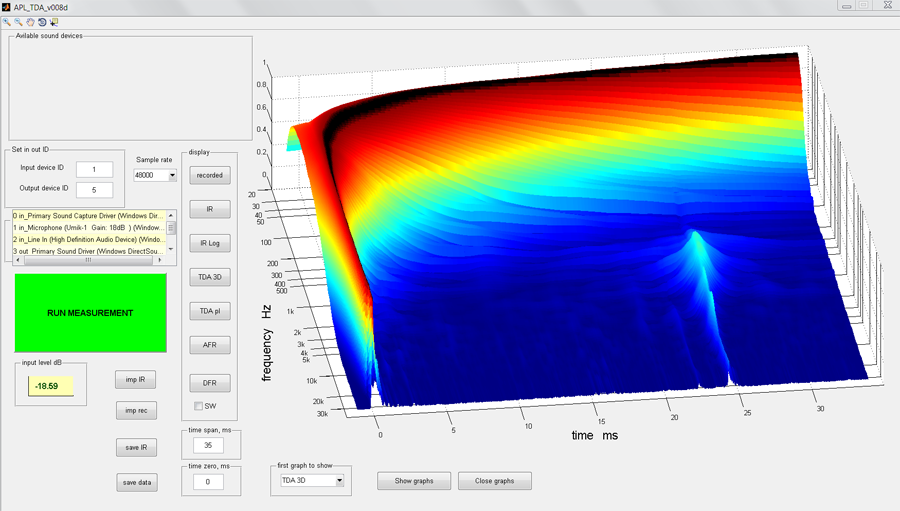
After nagging about it, REW software has a similar way to view your data. In the spectogram tab, set the settings to something like this:

It should get you a presentation close to that of APL_TDA. It can be useful to "see" what you're listening to.
That plot shown this way should tell you a little bit about your room and it's reflections. See how in Jim's room he has that ridge, set by him at ~25 ms and it shows strong energy from about 300 Hz up to 5 KHz. The wavelet plot makes it more visual than just being a spike on a 2D plot, doesn't it?
Now don't expect your room to do as well (or look as good) as the room from Jim. At least not without more work involved. If you follow the link there, you'll see my room too, before I put in my Haas Kicker. But that too, was after quite some work over time to get there (a family living room).
So don't give up, if you think you're moving in the right direction sound wise. Just study your room and try to bounce more energy to the back of it. Avoiding the listening spot with that bounce, obviously. You want to hear it bounce back from a diffuser panel, not before that. It won't be easy, that I can promise.
I do believe it's worth the trouble, but hey... I'm just another guy typing a message to you on the internet, am I not?
Another option would be to fake it like I do .
.
Did you listen to both? meaning the diffusers you build and the later placement of the flat panel reflectors?
If so, did you hear a change from your earlier setup? If you examine the thread from jim1961: My Listening Room - Gearslutz you'll notice he used many reflective panels to redirect sound to the back of the room, the same energy to be used with his diffuser panels. All of it was carefully planned with measurements to prove it's worth.
It took him years to optimize.
It is way easier for me to type it than it is for you to build it. The best example I have seen is that room from Jim. The measurements from that room were the most clear I've ever seen.
An example can be seen in this thread:
https://www.diyaudio.com/forums/full-range/284916-correction-speaker-correction-dsp-power-availabl-3.html#post4581506
In a piece of software, called APL_TDA Jim's room shows the arrival of the first wave front, followed by the Haas kicker:
After nagging about it, REW software has a similar way to view your data. In the spectogram tab, set the settings to something like this:
It should get you a presentation close to that of APL_TDA. It can be useful to "see" what you're listening to.
That plot shown this way should tell you a little bit about your room and it's reflections. See how in Jim's room he has that ridge, set by him at ~25 ms and it shows strong energy from about 300 Hz up to 5 KHz. The wavelet plot makes it more visual than just being a spike on a 2D plot, doesn't it?
Now don't expect your room to do as well (or look as good) as the room from Jim. At least not without more work involved. If you follow the link there, you'll see my room too, before I put in my Haas Kicker. But that too, was after quite some work over time to get there (a family living room).
So don't give up, if you think you're moving in the right direction sound wise. Just study your room and try to bounce more energy to the back of it. Avoiding the listening spot with that bounce, obviously. You want to hear it bounce back from a diffuser panel, not before that. It won't be easy, that I can promise.
I do believe it's worth the trouble, but hey... I'm just another guy typing a message to you on the internet, am I not?
Another option would be to fake it like I do
Attachments
Last edited:
as usual, you're being very helpful wesayso!
i set up the spectrogram the way you showed me, couple of questions
which frequencies are most important to focus on with the reflection and diffusion? i was focusing and sweeping from 1 khz up to 8khz, jim's setup is strong from 300 up to 5 khz or something, this matters and makes quite a difference in my ETC graph,
I'm trying to use flat panel reflectors are the sidewalls, ceiling, and front wall(behind the speakers), since my speakers are dipole they radiate quite a bit from there.
is there a way to figure out the angles the reflectors should be at to reflect at the back wall diffusers?( should come back at around 19ms)
I tried using a mirror and a partner but i need a way to do this myself
thanks alot for all your help!
i set up the spectrogram the way you showed me, couple of questions
which frequencies are most important to focus on with the reflection and diffusion? i was focusing and sweeping from 1 khz up to 8khz, jim's setup is strong from 300 up to 5 khz or something, this matters and makes quite a difference in my ETC graph,
I'm trying to use flat panel reflectors are the sidewalls, ceiling, and front wall(behind the speakers), since my speakers are dipole they radiate quite a bit from there.
is there a way to figure out the angles the reflectors should be at to reflect at the back wall diffusers?( should come back at around 19ms)
I tried using a mirror and a partner but i need a way to do this myself
thanks alot for all your help!
In my virtual Haas kicker I roughly use 200 Hz up to 3.5 KHz. I would go a bit lower if I could, the upper limit was set so the back energy didn't become a distraction itself, as in I heard some higher frequency sounds as coming from the back at times. That's not the purpose of the Haas Kicker.
I'd suggest using the mirror trick as wel . That's the easiest way I know off. I guess if I had to do it, I'd draw up the entire room in 3D to figure out the possible sound paths.
. That's the easiest way I know off. I guess if I had to do it, I'd draw up the entire room in 3D to figure out the possible sound paths.
Open Baffle might have it's own challenges in this case. Less reflections to the side walls, but plenty towards the wall behind the speakers. In theory one could reflect that over the listener out to the back .
.
I'd suggest using the mirror trick as wel
Open Baffle might have it's own challenges in this case. Less reflections to the side walls, but plenty towards the wall behind the speakers. In theory one could reflect that over the listener out to the back
200 Hz and lower.. that's pretty low for most diffusers or reflective panels to reflect, my diffusers are good from about 500 Hz and upwards, and the reflective panels I'm using at the first reflection points are definitely not reflecting that.
In your virtual Haas kicker case you can control the upper end of the kicker, what about the passive way though? in Jim's graph it looks like his energy goes up to 20 kHz if I'm reading that right.
Sweeping from 200 Hz to 3,5 kHz yields a way different result from what I was sweeping, which is 1 kHz till 8 kHz, the first reflections vary a lot and are denser and harder to kill below 1 kHz.
What to do here.. i need a constant frequency range to work with for killing early reflections and focusing on the later ones coming in
In your virtual Haas kicker case you can control the upper end of the kicker, what about the passive way though? in Jim's graph it looks like his energy goes up to 20 kHz if I'm reading that right.
Sweeping from 200 Hz to 3,5 kHz yields a way different result from what I was sweeping, which is 1 kHz till 8 kHz, the first reflections vary a lot and are denser and harder to kill below 1 kHz.
What to do here.. i need a constant frequency range to work with for killing early reflections and focusing on the later ones coming in
An OB speaker will radiate as much power to the wall behind the speaker as it does towards the listener. In a more traditional speaker one could redirect side wall energy to the back, just like Jim did. I'm guessing you'd need to redirect parts of that back wave to the back of the room to make up for that?
I chose to absorb side wall reflections and used fluffy fiberglass panels with wool felt of about 3" thickness (with an air gap between it and the wall) to reduce the abundance of energy I had at mid frequencies. That leveled my RT60 numbers, but in my living room it is higher than what you have now. My huge row of drivers will play a role in that, no doubt. I did want to keep liveliness (not kill the room completely) and with Haas Kiker in place it's actually more even than before.

I started with something like this:

(Before damping panels and a proper DSP recipe)
I'll have to redo everything soon though, as my arrays are undergoing surgery.
I chose to absorb side wall reflections and used fluffy fiberglass panels with wool felt of about 3" thickness (with an air gap between it and the wall) to reduce the abundance of energy I had at mid frequencies. That leveled my RT60 numbers, but in my living room it is higher than what you have now. My huge row of drivers will play a role in that, no doubt. I did want to keep liveliness (not kill the room completely) and with Haas Kiker in place it's actually more even than before.

I started with something like this:

(Before damping panels and a proper DSP recipe)
I'll have to redo everything soon though, as my arrays are undergoing surgery.
I have diffusers in place and 2 inch rockwool panels on the corners with 16 inch of air behind them acting as bass traps, that's all the treatment i have and the t30 is constant at 0,3 ms( below that is not accurate since i have a 50 hz problem in my room, something is making a 50 hz hum and causing a non decaying ringing measurement, i m actually decaying around 0.5, 0.6 ms below 100 hz, so i'm afraid more absorption would kill my room.
i currently have dipole speakers, well the tweater from 4 khz upwards in acting as a dipole only so not sure how much this is necessary, i'm thinking of killing the back of the speaker with absorption and reflect from the side walls and the ceiling to the diffusers back of the room
focusing on frequencies from 1 khz to 5 khz or something around there
i currently have dipole speakers, well the tweater from 4 khz upwards in acting as a dipole only so not sure how much this is necessary, i'm thinking of killing the back of the speaker with absorption and reflect from the side walls and the ceiling to the diffusers back of the room
focusing on frequencies from 1 khz to 5 khz or something around there
Attachments
One thing i read on a post that jim wrote, saying that redirecting all the energy to the back wall might be problematic, and usually lateral energy is sought after,
My room a width is 3 meters so there's no way i can make that happen, i might be able ro redirect the ceiling reflections to the front wall diffusers, and arrive around 18 ms, would that be preferable than everything to the back wall?
My room a width is 3 meters so there's no way i can make that happen, i might be able ro redirect the ceiling reflections to the front wall diffusers, and arrive around 18 ms, would that be preferable than everything to the back wall?
- Status
- This old topic is closed. If you want to reopen this topic, contact a moderator using the "Report Post" button.
- Home
- General Interest
- Room Acoustics & Mods
- Optimizing my room for the most HI FI music experience possible
